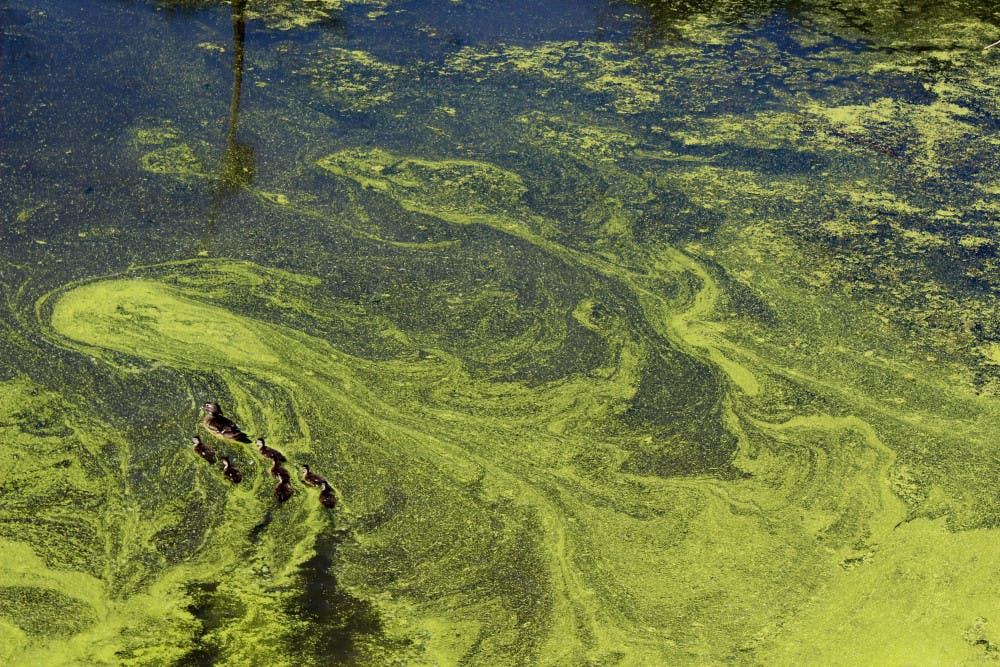By: Brandi Young
Algal blooms, most often cyanobacteria, also known as blue-green algae, can produce toxins when abundant and have been causing problems for the public for quite some time. When they are in “bloom” they appear to look like a colored film covering the surface of the water, this can be in a wide range of colors, however most often they appear green. They are referred to as “harmful algal blooms” or HABs when they are in abundance due to the effect that they can have on us and the environment. Harmful algal blooms can contaminate the water causing various sicknesses if ingested or skin irritation if it comes in contact with the body, not to mention the negative impacts on the surrounding wildlife.
In Ohio, HABs are most prominent in Lake Erie. In the 1950s, algal blooms were extremely common. This was largely due to the fact that at that time many farms were producing runoff from their fertilizers, and industrialization in general caused an excessive amount of phosphorus and other nutrients to enter the waters, allowing the algae to flourish. In the 1970s, there was a slight decline in the growth of HABs from the various regulations that were passed; the improvement of sewage systems and agriculture in general also had a positive effect on the amount of phosphorus that would reach Lake Erie.
Other ways Ohio has been addressing the HABs is through recent legislation. In 2019, Governor Mike Dewine started a water-quality program titled “H2Ohio”. This program included a two-year $172 million plan to create new wetlands, replace lead water pipes, and repair broken septic systems. It included a phosphorus reduction program that would pay farmers for reducing their impact and contribution to the phosphorus in the water systems. Currently, only farmers from the area are able to enroll, but Dewine plans on allowing other farmers in the state to enroll. One aspect of H2Ohio is to increase the wetlands in Ohio, meaning that water from the Chippewa inlet will be redirected to a newly built stream channel. This will reduce the amount of nutrients that currently stream into the lake, as well as restore old wetlands in the area.
The main goal to reduce these algal blooms (as laid out in H2Ohio) is to limit the amount of phosphorus that is let out into the environment. Some of the many ways to combat this is through legislation and “best management practices”, also known as BMP. Best management practices are ways of preventing and reducing the quantity of pollution that is put into the environment, some methods include: soil testing, manure incorporation, cover crops, crop rotation, and more.
One of the easiest ways to do this in your personal life is to implement cover crops, or green manure, into your garden at home. These are plants or crops that you can grow after your main harvest and are used to protect the soil. They grow in the opposite season of the main yield, generally in the winter, and can help reduce soil erosion by allowing the soil to retain certain nutrients which helps improve the overall health of the soil.Planting cover crops can also suppress weeds and provide a habitat for other wildlife to flourish.If you would like to know more about the benefits of cover crops, check out this article from the USDA.
Overall, I believe that cover crops, and their abundance of environmental benefits, are a very effective practice to put into use for farmers. Soil erosion prevention is an important step in reducing runoff from these Ohio farms. I think that the other actions of the H2Ohio plan will be helpful in reducing HABs and their risks to the surrounding environments. As for Ohio’s algae bloom future, I firmly believe that the H2Ohio program will slowly, but surely, aid in improving the water quality.
Photo courtesy of Unsplash.




